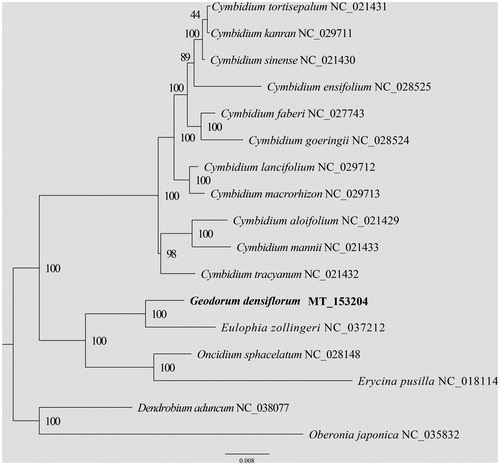Abstract
Geodorum densiflorum is a popular terrestrial orchid in the Southeast Asia. It has high medicinal and ornamental value. In this study, the chloroplast genome of G. densiflorum was determined from BGISEQ-500 sequencing data. The total chloroplast genome was 149,468 bp in length, consisting of a large single copy region (LSC 85,070 bp), a small single copy region (SSC 13,290 bp), and two inverted repeat regions (IRA and IRB 25,554 bp). The complete chloroplast genome contains 132 genes, including 76 protein-coding genes, 36 tRNA genes, and 8 rRNA genes. In addition, the phylogenetic analysis indicates that G. densiflorum was sister to Eulophia zollingeri. The chloroplast genome will contribute to the research and conservation of G. densiflorum.
Geodorum densiflorum is a perennial terrestrial orchid distributed in the Southeast Asia. It usually grows on grassy slopes, streamsides or in forests at altitudes of 300–2,400 m (Chen and Stephan Citation2009). G. densiflorum has a high ornamental value with white flowers and its pseudobulb has anti-diabetic effect (Li et al. Citation2012). Since the discovery and naming of this plant by German scientist Schlechter in 1921, the species has not been found in the wild, and it was not until 2004 that a population of less than 400 individuals of Geodorum eulophioides was found in the Yachang Orchidaceae National Nature Reserve (Feng et al. Citation2012). Unfortunately, with the over-excavation of Geodorum densiflorum, their habitats have been broken up and the wild resources have decreased significantly over the last decades. Therefore, the G. densiflorum is listed as an endangered species in the China Species Red List (Wang and Xie Citation2004). Therefore, we report the complete chloroplast genome of G. densiflorum, in order to better understand the relationship between G. densiflorum and related genera, and contribute to the effective conservation strategy of G. densiflorum.
In this study, the complete genomic DNA was extracted from fresh leaves using a modified CTAB method (Doyle and Doyle Citation1987) and sequenced by the BGISEQ-500 platform. The samples were collected from Yachang Orchidaceae National Nature Reserve, Guangxi, China (24°44′N, 106°15′E) and the voucher specimen deposited at Herbarium of Guangxi Institute of Botany, Guangxi Zhuang Autonomous Region and Chinese Academy of Sciences (specimen code Densiflorum_GX) .
The clean reads were used to assemble the complete chloroplast genome by the GetOrganelle pipe-line (Jin et al. Citation2018), with the chloroplast genome of Eulophia zollingeri (NC_037212) as the reference sequences. The assembled chloroplast genome was annotated using the Geneious R11.15 (Kearse et al. Citation2012). The physical map of the chloroplast genome was generated using the online tool OGDRAW (Lohse et al. Citation2013). Finally, we obtained a complete chloroplast genome of G. densiflorum and submitted to GenBank with accession number MT_153204.
The total chloroplast genome of G. densiflorum was 149,468 bp in length, consisting of a large single copy region (LSC 85,070 bp), a small single copy region (SSC 13,290 bp), and two inverted repeat regions (IRA and IRB 25,554 bp). The complete chloroplast genome contains 132 genes, including 76 protein-coding genes, 36 transfer RNA (tRNA) genes, and 8 ribosomal RNA (rRNA) genes. The GC content of the chloroplast genome of G. densiflorum is 37%.
To investigate the phylogenetic position of G. densiflorum, a phylogenetic analysis was performed based on 17 complete chloroplast genome sequences of Orchidaceae. All sequences were aligned with the HomBlock pipeline (Bi et al. Citation2018) and subsequently checked manually in Bioedit v5.0.9 (Hall Citation1999). Then, the phylogenetic tree constructed by RAxML (Stamatakis Citation2014) with 1000 ultrafast bootstrap (UFBoot) replicates (Minh et al. Citation2013; Chernomor et al. Citation2016). The results showed that G. densiflorum was sister to Eulophia zollingeri with 100% bootstrap support ().
Disclosure statement
No potential conflict of interest was reported by the authors.
Data availability
Data openly available in a public repository that does not issue DOIs. The data that support the findings of this study are openly available in [National Center for Biotechnology Information] at [https://www.ncbi.nlm.nih.gov/], reference number [MT153204].
Additional information
Funding
References
- Bi G, Mao Y, Xing Q, Cao M. 2018. HomBlocks: a multiple-alignment construction pipeline for organelle phylogenomics based on locally collinear block searching. Genomics. 110(1):18–22.
- Chen XQ, Stephan W. 2009. Flora of China. Vol. 25, Orchidaceae. Beijing: Science Press, Missouri Botanical Garden Press; p. 258–259.
- Chernomor O, von Haeseler A, Minh BQ. 2016. Terrace aware data structure for phylogenomic inference from supermatrices. Syst Biol. 65(6):997–1008.
- Doyle JJ, Doyle JL. 1987. A rapid DNA isolation procedure for small quantities of fresh leaf tissue. Phytochem Bull. 19:11–15.
- Feng CL, Cai SW, Deng ZH. 2012. Endangered causes and protection countermeasures of Geodorum eulophioides in Yachang forest region. Guangxi Forestry. Vol. 09; pp. 43–44.
- Hall TA. 1999. BioEdit: a user-friendly biological sequence alignment editor and analysis program for Windows 95/98/NT. Nucleic Acids Symp Ser. 41:95–98.
- Jin JJ, Yu WB, Yng JB, Song Y, Yi TS, Li DZ. 2018. GetOrganelle: a simple and fast pipeline for de novo assembly of a complete circular chloroplast genome using genome skimming data. bioRxiv. 256479.
- Kearse M, Moir R, Wilson A, Stones-Havas S, Cheung M, Sturrock S, Buxton S, Cooper A, Markowitz S, Duran C, et al. 2012. Geneious basic: an integrated and extendable desktop software platform for the organization and analysis of sequence data. Bioinformatics. 28(12):1647–1649.
- Li LM, Zhong YF, Song XQ, Jin XQ. 2012. Effect of light and coconut juice on the rhizome and shoot development of Geodimeter dendriform (Lam.) Schlater. Guangdong Agric Sci. 39(19):45–47.
- Lohse M, Drechsel O, Kahlau S, Bock R. 2013. OrganellarGenomeDRAW—a suite of tools for generating physical maps of plastid and mitochondrial genomes and visualizing expression data sets. Nucleic Acids Res. 41(W1):W575–W581.
- Minh BQ, Nguyen MAT, von Haeseler A. 2013. Ultrafast approximation for phylogenetic bootstrap. Mol Biol Evol. 30(5):1188–1195.
- Stamatakis A. 2014. RAxML version 8: a tool for phylogenetic analysis and post-analysis of large phylogenies. Bioinformatics. 30(9):1312–1313.
- Wang S, Xie Y. 2004. China species red list. Vol. 1, RedList. Beijing: Higher Education Press; p. 444.

